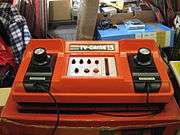Color TV-Game
|
The Color TV-Game Block Kuzushi. | |
| Manufacturer | Nintendo |
|---|---|
| Type | Dedicated console |
| Generation | First generation |
| Retail availability | 1977–1980[1] |
| Units sold | Japan: 3 million[2] |
| Successor | Famicom (NES) |
Color TV-Game (Japanese: カラー テレビゲーム Hepburn: Karā Terebi-Gēmu) is a series of five home dedicated consoles, created by Nintendo and sold only in Japan. Nintendo sold three million units of the first four models: one million units of each of the first two models, Color TV-Game 6 and 15; and half a million units of each of the next two models, Block Breaker and Racing 112.[2] The Color TV-Game series has the highest sales figures of the first generation of video game consoles.
History


Color TV-Game 6
The series debuted on June 1st, 1977 with the Color TV-Game 6 (カラー テレビゲーム6 Karā Terebi-Gēmu Roku).[1][3] The Color TV-Game 6 was jointly developed with Mitsubishi Electronics.[4] It contains six variations of Light Tennis (or Pong). The players control their paddles with dials attached directly to the machine. Additionally, as an alternative to the standard version, a white-colored C battery powered model of the Color TV-Game 6 was introduced. These white colored units had a limited run of only a few hundred units.
Color TV-Game 15
On June 8th, 1977, just a week after the TV Game 6, Nintendo released the Color TV-Game 15 (カラーテレビゲーム15 Karā Terebi-Gēmu Jū Go).[5] With the two controllers now on cables (making for much more comfortable play) and 15 slightly different versions of Light Tennis, the CTG 15 yielded sales of more than one million units. Two models of the CTG 15 were released, differing only by a slight color tint change. It appears as an "Assist Trophy" in Super Smash Bros. for Nintendo 3DS and Wii U.
Color TV-Game Racing 112
On June 8th, 1978, Nintendo released the Color TV-Game Racing 112 (カラーテレビゲームレーシング112 Karā Terebi-Gēmu Rēshingu Hyaku Jū Ni), a bird's-eye-view racing game that implements a steering wheel and gearshift. Alternatively, two smaller controllers can be used for multiplayer.
Color TV-Game Block Breaker
The "Color TV-Game Block Breaker" (カラーテレビゲームブロック崩し Karā Terebi-Gēmu Burokku Kuzushi) was released on April 23rd, 1979; the 1-player console runs a ported version of "Block Breaker" (ブロック崩し Burokku Kuzushi), one of Nintendo's arcade games based on Atari's Breakout. Like the Color TV-Game 6, the in-game paddle was controlled by a dial attached to the system. The system's external design was one of Shigeru Miyamoto's first video-game projects after joining Nintendo in 1977.
Computer TV-Game
The final console in the series is the Computer TV-Game (コンピューターテレビゲーム Konpyūtā Terebi-Gēmu), released in 1980. The only game in this console is a port of Nintendo's first video arcade game, Computer Othello.
Legacy
More than two decades after their release, Nintendo featured Color TV-Games in its WarioWare series. WarioWare, Inc.: Mega Microgame$!, released for the Game Boy Advance in 2003, includes a microgame version of Color TV Racing 112, as part of 9-Volt's collection of classic Nintendo games. Color TV-Game 6 also became a microgame as one of 9-Volt and 18-Volt's Nintendo games in WarioWare: Smooth Moves, released for the Wii in 2006. The Color TV-Game 15 appears as an Assist Trophy in 2014's Super Smash Bros. for Nintendo 3DS and Wii U.
| Nintendo Color TV-Game series | ||||||||||||
|---|---|---|---|---|---|---|---|---|---|---|---|---|
|
See also
- Dedicated console
- Game & Watch
- History of Nintendo
- Nintendo Entertainment System
- List of million-selling game consoles
References
- 1 2 DeMaria, Rusel; Wilson, Johnny L. (2003). High Score!: The Illustrated History of Electronic Games (2 ed.). McGraw-Hill. pp. 363, 378. ISBN 978-0-07-223172-4.
- 1 2 Sheff, David; Eddy, Andy (1999). Game Over: How Nintendo Zapped an American Industry, Captured Your Dollars, and Enslaved Your Children. GamePress. p. 27. ISBN 978-0-9669617-0-6.
Nintendo entered the home market in Japan with the dramatic unveiling of Color TV-Game 6, which played six versions of light tennis. It was followed by a more powerful sequel, Color TV-Game 15. A million units of each were sold. The engineering team also came up with systems that played a more complex game, called "Blockbuster," as well as a racing game. Half a million units of these were sold.
- ↑ Fleming, Dan (1996). Powerplay. Manchester University Press ND. p. 180. ISBN 978-0-7190-4717-6.
- ↑ Subramanian, Annapoornima M; Chai, Kah-Hin; Mu, Shifeng (2011). "Capability Reconfiguration of Incumbent Firms: Nintendo in the Video Game Industry". Technovation. 31 (5).
- ↑ "【任天堂「ファミコン」はこうして生まれた】第2回:電卓をあきらめてゲーム機ヘ". nikkeibp.co.jp (in Japanese). Nikkei Business Publications, Inc. 2008-09-30. Retrieved 2015-02-24.
こうして任天堂は1977年に、価格9800円の「カラーテレビゲーム 6」と、価格1万5000円の「カラーテレビゲーム 15」を売り出すことになる。
- Sheff, David; Eddy, Andy (1999). Game Over: How Nintendo Conquered the World. GamePress. pp. 15, 27–28, 32. ISBN 978-0-9669617-0-6.

.jpg)
.jpg)


